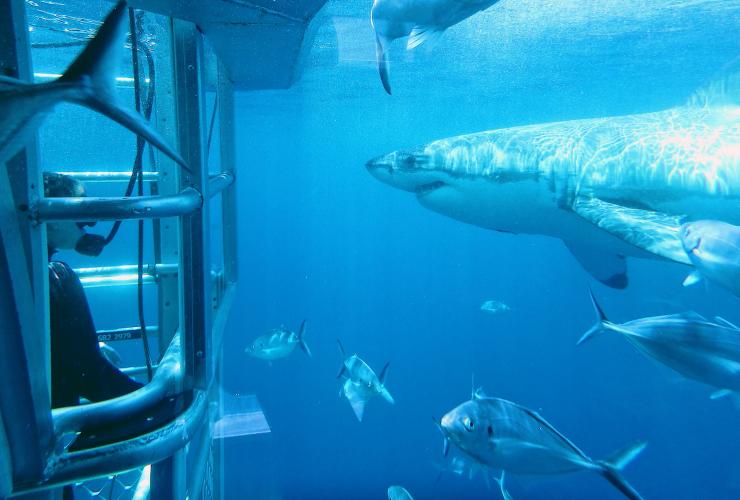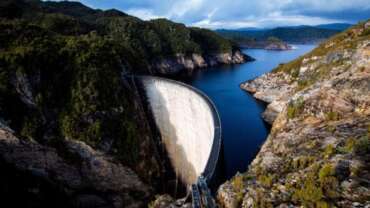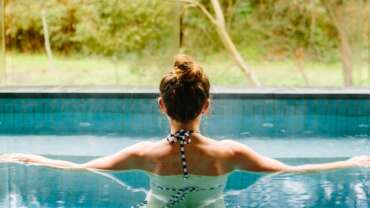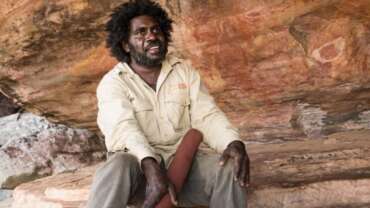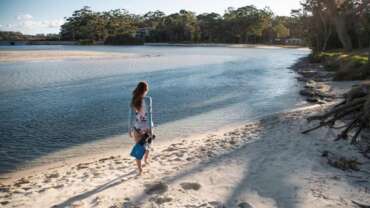Wildlife Tours Australia
From elusive echidnas to adorable wombats, Australia boasts some of the most unique wildlife on the planet.
Nowhere else in the world can you watch kangaroos hop across beautiful pastures, spot koalas sleeping in gum trees or snorkel with schools of fish on the Great Barrier Reef. See saltwater crocodiles in their natural habitat, snap a selfie with a quokka or swim with Australian fur seals in wildlife experiences you won’t find anywhere else.
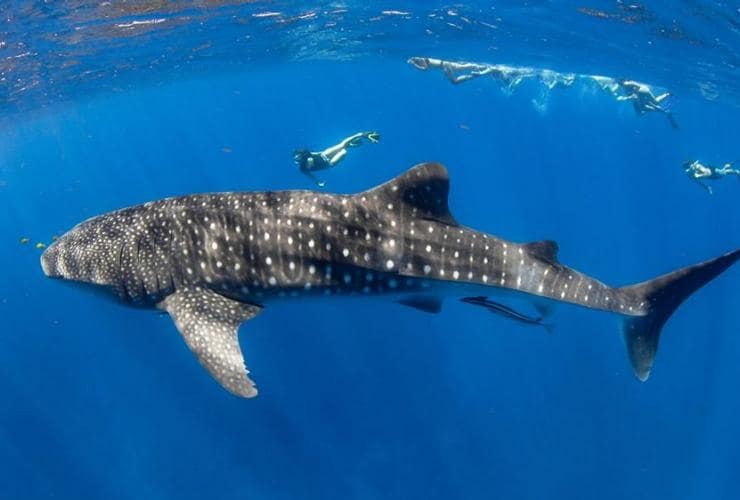
Unique Australian wildlife experiences
Australia is celebrated for its extraordinary wildlife and provides many opportunities for close and personal interactions with some amazing animals, from floating beside a magnificent whale shark, cuddling a koala or spotting a crocodile on the banks of a billabong.
Australia’s wildlife is incredibly unique, with many species found nowhere else in the world. While zoos and wildlife parks offer great opportunities to see animals up close, there are also plenty of other places to see Australian animals in their natural habitats. You can watch Tasmanian devils play-fight, spot kangaroos relaxing by the beach, get a photo with a quokka and, if your nerves are up to it, get nose to nose with a great white shark. Here are just a few of Australia’s most extraordinary wildlife experiences.
Dive with the ocean’s gentle giants: whale sharks and humpbacks
About halfway up the West Australian coastline, Ningaloo Marine Park is the only place on the planet where large numbers of whale sharks are known to reliably visit so close to land. Join a one-day marine tour in holiday towns of Exmouth or Coral Bay from April to July and snorkel alongside these 14-metre (46-foot) harmless vegetarians. Western Australia’s whale sharks share the warm waters with tropical fish, manta rays, turtles, dolphins and whales, and from July to October, you can also swim with migrating humpback whales off Ningaloo Reef. These gentle whales are also found migrating along the coast of Queensland between July and November, known as the ‘Humpback Highway’ among locals, offering another chance to see them up close. Sunreef departs from Mooloolaba, just a 15-minute drive from Sunshine Coast Airport, and offer half-day tours.
Spot koalas sleeping in the trees
Victoria’s Great Ocean Road is one of Australia’s most breathtaking drives. It winds along the state’s south-west coast, taking in cliffs, forests, hairpin bends and seaside towns. It also leads to clusters of grey koalas, hidden high in the treetops. The best place to find them is along Lighthouse Road, Cape Otway, which diverts off the scenic route about 20 kilometres (12 miles) from the town of Apollo Bay. Koalas are everywhere, but they’re well camouflaged, so you may not see them at first. Train your eyes and soon you’ll be spotting them like a pro. Here’s a tip: don’t stop at the first bunch of cars parked beneath a tree – just beyond you should get koalas all to yourself. Continue to the end of the cape to visit Australia’s oldest surviving lighthouse.
Meet a Tasmanian devil
Tasmania’s Saffire Freycinet, one of Australia’s top luxury hotels, runs a retirement home for Tasmanian devils, where guests can observe these endangered animals enjoying their daily feed in a one-hectare (2.5-acre) enclosure that mimics their natural surrounds. If you’re visiting Cradle Mountain, Devils @ Cradle is another nearby sanctuary where you can see and learn more about these unique native animals.
Snap kangaroos relaxing on the sand
It’s an unusual sight, and one you’re not likely to forget. The eastern grey kangaroos at Pebbly Beach, on the South Coast of New South Wales, love to relax and soak up the sunshine. You’ll see them in large numbers on the grass and sand. Many of them at the popular surfing and bushwalking spot, about 270 kilometres (168 miles) south of Sydney, don’t mind posing for photographs either. In Western Australia, head to Lucky Bay (just a 40-minute drive from Esperance) to see them lounging on the white sands, while in Queensland you’re guaranteed to spot ‘roos and wallabies on the beach at Cape Hillsborough, near Mackay.
Watch saltwater crocs swim by
Feel the hairs rise on your arms, even as the sun warms your skin when you first lay eyes on the ridged back of a Northern Territory crocodile. These massive reptiles move through the water noiselessly, causing only minor ripples as they slide just beneath the surface. In the heart of Kakadu National Park, a two-hour cruise on Yellow Water billabong is an unforgettable way to watch this proficient predator in its natural habitat.
Float over a reef with sea turtles
When you snorkel over the coral gardens of the Great Barrier Reef, you may feel as though your mask isn’t big enough to take everything in. Just off the sandy shores of Lady Elliot Island, a coral cay at the southern end of the World Heritage-listed reef, sea turtles flit through the aquamarine waters. You’ll likely encounter them along one of the many snorkelling trails, which you can swim on your own using a free map, or by joining a guided snorkel safari. The lagoon on the eastern side of the island is particularly rich with sea life. If you’ve never snorkelled before, you can take one of the island’s free lessons. If you’d rather stay dry, jump aboard the glass-bottomed boat for views of tropical fish and colourful corals.
Smile at foraging wombats
As dusk falls over the beautiful Wilsons Promontory National Park in Victoria (a three-hour drive south-east of Melbourne), solid, rotund animals with short legs and twitching noses emerge. Wombats are naturally shy, nocturnal creatures, but at dusk they emerge from their burrows to feed on grasses, and can often be seen at the entrance to the main beach and thumping heavily through the camping grounds. While you’re here, expect to also come across kangaroos, emus, echidnas and rosellas.
Snap a selfie with a quokka
Western Australia’s quokkas are among the cutest marsupials around. On Rottnest Island, just off the coast of Perth, they hop around cheerfully, stopping to watch as people relax at the pub, play a round of golf or cycle on the car-free island. Rarely seen anywhere else in the state, they have a social nature and those in the settlement area are happy to pose for selfie photographs, something that’s become a trend after numerous celebrities, including Hugh Jackman, Chris Hemsworth and Margot Robbie, posted their snaps online.
Get face to face with a great white shark
This one is for the thrill seekers. If the chance to jump in a cage, be lowered underwater and face a great white shark powering towards meat dangled in front of you sounds like fun, then be our guest. In the deep waters off the coast of Port Lincoln, on the southern tip of South Australia’s Eyre Peninsula, specialist charter boats steam out to shark-infested waters for full-day experiences. Safety is, naturally, priority number one, but that doesn’t make the adrenaline rush any less acute. If you prefer to stay dry, a glass aqua-sub is another option, or for some extra scare factor, go at twilight.
Dive with the dwarf minke whales
Australia’s Great Barrier Reef offers many wonders, but there’s no way you should pass up the opportunity to swim with pods of dwarf minke whales. Famous for being highly inquisitive, minke whales have been known to spend hours swimming with humans, even bringing their calves with them for an introduction. The Great Barrier Reef is the only place on Earth they’re known to congregate and feed between the months of May and August each year. You can meet them on a day trip or overnight expedition departing from Cairns or Port Douglas.
Tiny Turtle hatching
Green and loggerhead turtles love Heron Island, just off the Gladstone coast, because the reef here touches the shoreline, meaning the shallow waters are full of food for nesting season. The coastal reef makes Heron an excellent place for daytime snorkelling, too, but you’ll want to stay overnight during hatching season. Heron Island Resort – the only accommodation on the island – has spacious rooms with reef views and an al fresco restaurant worth writing home about. Back on the mainland, the beach within Mon Repos Conservation Park, on the outskirts of picturesque Bundaberg, is another haven for turtles – in fact, more mothers nest at Mon Repos than anywhere else on the east coast. The Queensland Parks and Wildlife Service run ranger-guided night-time turtle encounters during hatching season.
Penguins on Phillip Island
Located just a 90-minute drive south of Melbourne, Phillip Island is a wildlife haven. One of the area’s most popular events, the Penguin Parade allows visitors to catch a glimpse of the island’s native little penguins as they come back ashore after a day of fishing. Head to Summerland Beach for a 180-degree viewing of the parade on their tiered seating. There are also several VIP and guided tours on offer for up-close viewing and ranger commentary. Alternatively, try to catch a glimpse of them in their burrows from the elevated timber boardwalks around the island. With over 32,000 little penguins living on the island, you’ve got a good chance of spotting a few.
Salute the sea lions
If their name isn’t already a dead giveaway, Australian sea lions are endemic to Australia. These friendly ‘puppies of the sea’ are incredibly playful, and naturally inquisitive, and will often swim right up to humans nearby. They patrol the waters off the West Australian coast, Victoria, and South Australia. You can get up close and personal on the Coral Coast (three hours north of Perth), where the local sea lions are commonly spotted sunbathing on the beaches of Jurien Bay Marine Park, or you can take a boat from Jurien Bay or Green Head and jump in the water for a snorkel as they swirl around you. There’s also a large colony that live in Kangaroo Island’s Seal Bay, and visitors are encouraged to take a research tour held at either sunrise or twilight led by an experienced guide.
Play with a platypus
In Queensland’s Mackay region – a tropical area known for its waterfalls, rainforests and ancient volcanic soils – you’ll find a very rare, very special experience indeed. The native Australian platypus (famous for its duck-like bill and webbed feet) is notoriously shy, but in a remote rainforest you can dive with them. Dives take place at dawn and dusk, when these beautiful animals are most active. Slip underwater and look out for turtles, fish and other fascinating marine life, too. If you’d rather not get wet, then head to the Healesville Sanctuary in Badger Creek, where you can play zookeeper for the day to touch, play and feed the platypus on site.
Glide with manta rays
With a wingspan of up to seven metres (22 feet), the manta ray is the world’s largest ray. Despite their impressive size, these majestic creatures are safe to swim, snorkel or dive with as they don’t have the sharp barb of other rays. The giant rays can be found feeding throughout the year at Lady Elliot Island in the Southern Great Barrier Reef or at Coral Bay on the famous Ningaloo Reef. Watch closely and you may see the acrobatic skills of the males on display as they compete for female attention.
Spot wild dingoes
Not quite a dog, and definitely not a wolf – the Australian dingo is a wild animal and an Australian icon. While they are generally recognised by their rich copper coat, they come in whole heap of colours. They can be white, which means the dingo comes from the alpine regions of Australia, and they can also be black, usually found in forest and rainforest areas. You can find them at the Australian Reptile Park (just outside of Sydney) and at most zoos and wildlife sanctuaries, but if your heart is set on seeing them in the wild, your best bet is to visit Queensland’s Fraser Island where visitors can observe the local wildlife in their own habitat.
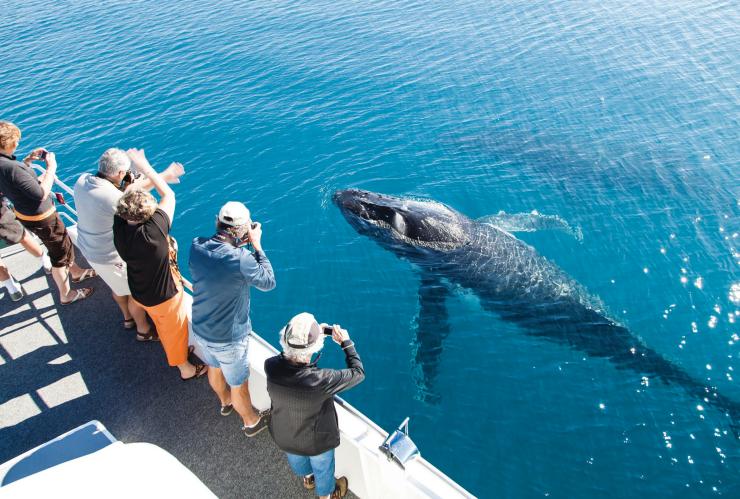
Seasonal wildlife events
Time your trip to Australia with these incredible seasonal wildlife events.
Australia is home to an extraordinary array of wildlife, much of which can be spotted all year round. There are, however, a series of spectacular seasonal fauna events that take place around the country which are bound to impress even the keenest wildlife-watcher. Pack your binoculars.
Walk the red crab carpet
When: November – January
Where: Christmas Island
Christmas Island, off the far north-west coast of Australia, is home to an estimated 40-50 million bright red land crabs. Each year, at the start of the wet season, a spectacular awakening occurs. Mother Nature literally rolls out the red carpet as hordes of crabs emerge from the island’s forests and march their way down to the ocean to breed. Timing is linked to the phases of the moon, so that eggs can be released into the ocean at the exact turn of the high tide. It’s a sensational sight – the crabs move in streams, climbing down cliff faces and over obstacles, following the same routes used year after year. After several weeks, the larvae-turned-tiny crabs emerge from the ocean and begin the week-long journey inland. The red crab carpet then disappears into the forests, not to be seen until the crabs reach adulthood – and the cycle begins again.
Take in the tiny turtles
When: November – January (nesting), January – March (hatching)
Where: Southern Great Barrier Reef
If you love turtles, Queensland is the perfect location to see their incredible cycle of life for yourself. Although turtles can be found in a few key hotspots around Australia, they tend to be particularly prolific in the Southern Great Barrier Reef region, which spans from the coastal town of Bundaberg to Yeppoon. If you’re visiting in summer (November to January), you’ll be treated to the sight of massive female green and loggerhead turtles hauling themselves onto the beaches of mainland Mon Repos and the tiny islands of Lady Elliot, Heron and Lady Musgrave to lay their eggs. From January onwards, witness the race to the water as the tiny hatchlings start to push their way out of their sandy nests and scurry down to the ocean – it’s quite an incredible sight.
Welcome Australia’s whale sharks
When: March – July
Where: Ningaloo Reef, Western Australia
For a chance to swim next to the largest fish in the ocean, head to Western Australia for the incredible whale shark migration. These gentle giants gather annually off Western Australia’s Coral Coast, which is home to the famous Ningaloo Reef. Although whale sharks’ exact migration patterns remain a mystery, they seem to arrive around March each year and stick around until mid-winter (July or August). So, what’s the best way to see these colossal creatures up close? The simple answer is to dive right in. Local tour operators in Exmouth and Coral Bay run whale shark swim tours, where you’ll get to float alongside these gargantuan fish. A helicopter flies overhead as a spotter, so in case you were envisaging hours of treading water waiting for whale sharks to make their cameo, there’s no cause for concern. Simply relax in comfort on the boat, then when a whale shark is spotted it’s time to jump in.
Observe a gathering of orcas
When: Late January – April
Where: Bremer Bay, Western Australia
If you haven’t heard of Bremer Bay, you’re probably not alone – it’s only been a few years since this tiny community on the remote south coast of Western Australia was thrust into the eco-tourism spotlight with the discovery of the ‘Bremer Canyon’. In a nutshell, the Bremer Canyon is a series of oceanic rifts 70 kilometres (43 miles) from shore which funnel cool, nutrient-rich waters upwards, attracting an abundance of marine life. While photos and newspaper clippings of this local phenomenon have adorned the walls of the Bremer Bay pub for decades, the hype only set in when ABC documentary ‘The Search for the Ocean’s Super Predator’ was aired in 2013. The program revealed a deep-sea battlefield that takes place every autumn, where apex predators including orcas, giant squid and great white sharks come to feast each year. Orcas are the highlight – you can join a daily research boat tour where the sighting rate is 98% – making it a highly reliable expedition and one of the largest congregations of killer whales in the southern hemisphere.
Spot birds of a feather
When: July- November
Where: Kakadu National Park, Northern Territory
Voted Australia’s number one bird watching destination by Australian Geographic, a trip to Kakadu National Park in the Northern Territory should be on any keen twitcher’s bucket list. Home to more than 280 types of birds – that’s around a third of Australia’s species – birdwatchers will be in paradise in this lush national park near Darwin. The best time to birdwatch here is during the dry season (May to October) – especially towards the end, as the water recedes, and the birds congregate on shrinking billabongs and waterholes. Large water sources such as Yellow Water Billabong and Mamukala Wetlands become a haven for magpie geese, plumed whistling ducks, brolgas, jabirus and egrets, which makes for phenomenal photography.
Find manta ray mayhem
When: May – August
Where: Lady Elliot Island
Although they can be spotted in various locations on both the Great Barrier Reef and Ningaloo Reef throughout the year, there’s a tiny island off the coast of Bundaberg in Queensland that is undeniably the cream of the crop when it comes to spotting manta rays. Known as ‘the home of the manta ray’ and featured in David Attenborough’s Great Barrier Reef documentary, Lady Elliot Island in the Southern Great Barrier Reef has made a name for itself as a hotspot for these giant kites of the sea. Mantas can be seen feeding around the island year-round, but aggregate in larger numbers during the winter months (July to September). And, if conditions are optimal and plankton is abundant, you might be lucky enough to witness what’s known as a ‘feeding frenzy’ – the sensational sight of large groups of mantas feeding at the water’s surface.
Cruise the humpback highway
When: May – November
Where: West and east coasts of Australia
Ok, so you’ve been whale watching, and you’re thinking ‘what’s the big deal?’. The big deal is the sheer number of whales that migrate along Australia’s east and west coasts – we’re talking tens of thousands of humpbacks, not to mention a solid smattering of southern right and blue whales. The whales head north to the warmer waters of Tropical North Queensland and the Kimberley to calve then back down the coast, resulting in the longest whale watching season in the world. Hotspots on the east coast include the Whitsundays, Hervey Bay, the Gold Coast, Sydney and the Sunshine Coast, where you can even swim with humpback whales. Over in Western Australia, your best whale watching spots are the coastal towns of Albany, Augusta, Busselton, Fremantle and Broome.
Swim with dwarf minke whales
When: July – September
Where: Cairns or Port Douglas
There’s only one spot on the planet where you can swim with dwarf minke whales – and only a few lucky people get the chance to do so each year. These six-tonne (6.6-ton) creatures are renowned for their fascination with humans – they’re so curious they have been known to spend hours swimming back and forth around divers, making eye contact and even bringing their calves for a look. However, they only congregate on the Great Barrier Reef for a brief period each winter (July to September) and swimming with them is a fiercely guarded privilege. Whether you take a day trip from the town of Port Douglas or join a multi-day liveaboard expedition from the region’s main city, Cairns, your interaction doesn’t start until the whales decide to approach. Once your boat is in the right area, you’ll slip into the water and float, snorkel mask on, while holding onto a rope. Then you’ll simply wait until the curious creatures decide to come to investigate – usually, something that happens within a matter of minutes. It’s definitely a bucket list experience for an avid diver or wildlife lover.
Snorkel with colourful giant cuttlefish
When: July
Where: Stony Point, Eyre Peninsula
Swim with the Giant Cuttlefish is a tour in South Australia that takes you snorkelling with the amazing giant cuttlefish at Stony Point, located on the coastline of the Upper Spencer Gulf Marine Park in the Eyre Peninsula. Their two-day tour itinerary, which has departures available to book during the cuttlefish migration season in July, is packed with added benefits that include exclusive cuttlefish insights by a marine expert, sightseeing through the wilderness of the Southern Flinders Ranges and hiking along the rugged Alligator Gorge in the Mount Remarkable National Park. The tour includes return transport from Adelaide and all equipment.
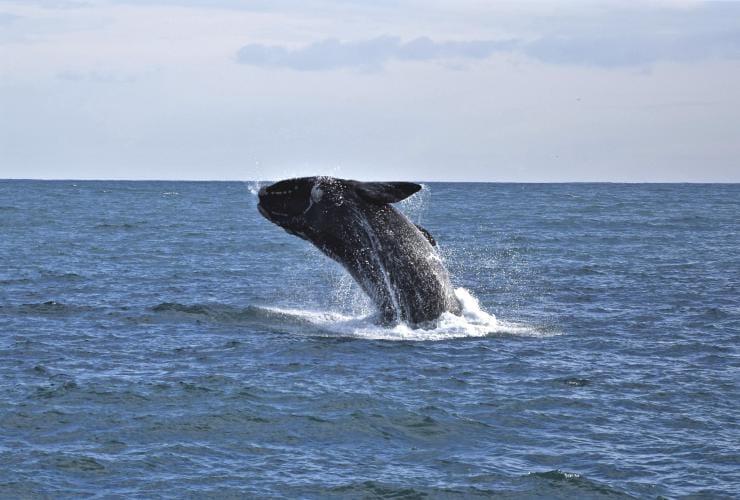
Whale watching in Australia
Spot southern right, dwarf minke, humpback whales and even orcas as they make their annual migration along Australia’s coasts.
The Australian coastline provides bountiful opportunities to observe any number of whale species on their annual migration. Spectators on both the east and west coasts have the chance to enjoy their own whale show, twice a year, as the mammals travel to and from Antarctica for what should be known as ‘the world’s longest lunch’ – feasting on all types of fish, krill, and plankton. At the tail-end of summer, they begin the long journey north to warmer waters for their breeding and birthing season, as young calves don’t yet have enough blubber on them to withstand the winter temperatures. Between May and November, you can spot southern right whales journeying to the temperate breeding waters off South Australia and Victoria, while energetic humpback whales continue north to the Great Barrier Reef and the Kimberley and orcas congregate off the southern coast of the state of Western Australia.
Here are the best spots around the country to take in their majestic beauty.
Near Hobart
When: May – July, September – December
Where: Legend has it that the residents of Hobart’s suburb of Taroona used to complain about being kept awake by the sounds of whales in the River Derwent. While whaling in the 19th century had a dramatic impact on the population, the whale numbers are recovering, and Tasmania’s east coast is still one of the best places to spot them on their annual migration. See humpback whales and southern right whales coasting through the clear waters of Great Oyster Bay off the Freycinet Peninsula, an area renowned for its pink granite cliffs and secret white beaches. Frederick Henry Bay is another great spot to grab a glimpse of the passing whales while still on dry land. Southern right whales and humpback whales often travel past the bay on the way to their breeding areas, but occasionally will stick around to give birth in Tassie, giving people the chance to see them from shore. You may also glimpse whales with their calves in Mercury Passage off Maria Island, a natural wildlife sanctuary.
How: Try a three-hour tour with Bruny Island Cruises to see whales taking shelter in Adventure Bay. Pennicott Wilderness Journeys also operate cruises and day tours from Hobart.
Near Perth
When: June – November
Where: In Western Australia, the south coast is the best place for spotting whales. Humpback whales and southern right whales frolic in Augusta’s picturesque Flinders Bay (in the Margaret River wine region) from early June, and then watch rare blue whales and their calves join bottlenose dolphins in Geographe Bay in Dunsborough in September. Further south, Albany’s rugged coastline makes another scenic grandstand as southern right whales take shelter in Albany’s bays to mate and calve before returning south. Just under two hours east of Albany is Bremer Bay, home to one of the largest congregations of killer whales in the Southern Hemisphere. Head out on a research boat to spot them. Visitors to Albany can also learn about whales at the historic Whaling Station, an interactive museum built in the headquarters of the last whaling company to cease operations in Australia. From June to November, humpback whales can also be spotted travelling north-west to Broome (a 2.5-hour flight from Perth). And while Ningaloo Reef in Exmouth is famous for its swimming with the whale shark experience, it also sees the highest number of humpback whales in the Southern Hemisphere. Around 30,000 pass through Exmouth between June and November on their way to their birthing grounds off the Kimberley coast. A number of operators in the area offer small-group tours that allow you to swim with these incredible mammals
How: Naturaliste Charters offer ocean adventures that depart from Albany, Augusta, Dunsborough, Busselton and Bremer Bay. Ningaloo Coral Bay Boats run a four-hour cruise out of Coral Bay, and Live Ningaloo offer a swim with humpback whale tour departing from Exmouth.
Near Sydney
When: May – late November
Where: Occasionally lucky Sydneysiders walking the famous Bondi to Coogee coastal track will catch a glimpse of passing humpbacks travelling north. The most common period is the last week of June and the first week of July. Then, in early September you’ll have another great chance of the mothers and calves passing by Sydney as they head back south. From land, Sydney’s best vantage point is The Gap at South Head in Watsons Bay. Outside of the city, head for Jervis Bay, a three-hour drive south of the city, where you’re almost guaranteed a whale sighting in the calm, clear waters. The Shoalhaven Heads, Crookhaven Heads Lighthouse and Penguin Head at Culburra Beach offer great outlooks. Or hop onto one of the cruises leaving daily between May and November from Huskisson. Continue 3.5 hours further south to the coastal town of Merimbula on the beautiful Sapphire Coast, for both shore-based whale watching and charters. The town of Eden celebrates their arrival each year with the Eden Whale Festival, with live shows, a parade and local produce stalls. You can also see the same huge, graceful creatures from June in Byron Bay, playing just offshore from the Cape Byron Lighthouse.
How: Book a three-hour Discovery Cruise with Whale Watching Sydney from Circular Quay out into Sydney Harbour, where humpbacks make their way up the east coast. Jervis Bay Wild offers eco-cruises that leave from Huskisson and travel around Jervis Bay. Merimbula Marina offers regular whale watching cruises from May through to November with 100 per cent success rate.
Near Adelaide
When: June – September
Where: Victor Harbor, located 80 kilometres (49 miles) south of Adelaide, is a significant historic location for both the Ramindjeri people and the early colonial settlers alike who prized the area for its rich lands, sheltered waters and whales. Holiday goers now flock to the coastal destination to enjoy its clear turquoise waters and abundant wildlife, including the majestic southern right whales who come year on year to breed. Stand atop the steep cliffs around Victor Harbor’s Encounter Bay to watch these visitors frolic in the calm waters below. Or better yet, book a tour to see them play with their calves further out in the waters of the Fleurieu Peninsula. Further along South Australia’s jagged coastline in Ceduna, you can watch the whales do slow-motion somersaults from the viewing platform or beach.
How: The Big Duck Tour offers both group and chartered cruises that depart from Victor Harbor, Granite Island Causeway and Adelaide. Ceduna Tours will take you to the head of the Great Australian Bight Whale Sanctuary where you can get up close to southern right whales in their breeding ground near the towering Bunda Cliffs.
Near Brisbane
When: May – November
Where: Queensland’s whale hot spot is at Hervey Bay, around 300 kilometres (186 miles) north of Brisbane. This tranquil spot is protected by Fraser Island, affording humpback whales the opportune location to hang around a while, either to mate, breed or nurse. To increase your chances of seeing the precious baby whales, time your visit around the first week of September. Each year in July and August, the arrival of the humpback whales is celebrated at the Hervey Bay Whale Festival, with concerts, street parades and displays. A bit further south, on the Sunshine Coast, adventure lovers can experience what it feels like to be part of a pod when they head out with Sunreef Mooloolaba to swim with humpbacks. If you keep travelling north until you reach the Whitsunday Islands, you can also get quite a show of humpback whales who tend to move into the area between May and September, enjoying the shallow, sheltered waters while they nurse their newborn calves. For a truly unforgettable experience, book in with one of the specialised operators to swim with dwarf minke whales. It is the only place in the world where people can dive with these highly intelligent, curious creatures and it only happens for a brief period in June and July. The encounters are always whale initiated and controlled, as swimmers are dropped into the appropriate area of water with their snorkels and instructed to hold onto a rope. The curious whales will then almost always come in for a closer look and have been known to spend hours swimming back and forth around divers, making eye contact and even bringing their calves for a look.
How: See the playful antics of the humpback whales aboard the Spirit of Hervey Bay, while legendary guide Vicky Neville from Tasman Ventures is often referred to as ‘the whale whisperer’. Mike Ball Dive Expeditions is one of the few lucky operators on the Great Barrier Reef who takes tour groups out to dive with the dwarf minke whales.
Near Melbourne
When: May – September
Where: Head to Logans Beach in Warrnambool, a three-hour drive out of Melbourne along the Great Ocean Road, and watch southern right whales calve in a nursery close to shore. They stay here for several weeks, helping their babies build strength for the long journey back to sub-Antarctic waters. You can capture the mother-and-calf interactions from the viewing platform on the sand dunes. Also try Lady Bay in Warrnambool, where the new mums often come close enough to spray you with breakwater. Travel a further 1.5 hours along the Great Ocean Road to see rare blue whales in their last feeding month at Cape Nelson near Portland.



